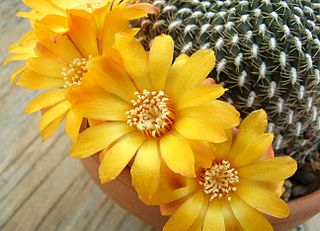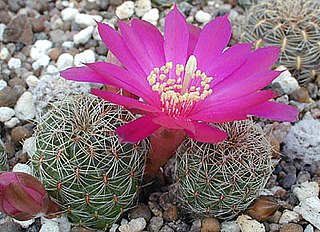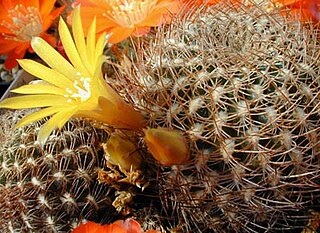
The International Union for Conservation of Nature (IUCN) Red List of Threatened Species, also known as the IUCN Red List or Red Data Book, founded in 1964, is an inventory of the global conservation status and extinction risk of biological species. A series of Regional Red Lists, which assess the risk of extinction to species within a political management unit, are also produced by countries and organizations.

Rebutia is a genus of flowering plants in the family Cactaceae, native to Bolivia and Argentina. They are generally small, colorful cacti, globular in form, which freely produce flowers that are relatively large in relation to the body. They have no distinctive ribs, but do have regularly arranged small tubercles. They are considered fairly easy to grow and they may produce large quantities of seeds that germinate freely around the parent plant.

Weingartia is a genus in the family Cactaceae, with species native to Bolivia and Argentina. Molecular phylogenetic evidence suggests that it may be distinct from Rebutia. It is treated as a synonym of that genus by Plants of the World Online as of September 2023, but recognized as an alternative generic name in the third edition of the CITES Cactaceae Checklist. It may also be treated as Rebutia subg. Weingartia.

An IUCN Red List Critically Endangered species is one that has been categorized by the International Union for Conservation of Nature as facing an extremely high risk of extinction in the wild. As of December 2023, of the 157,190 species currently on the IUCN Red List, 9,760 of those are listed as Critically Endangered, with 1,302 being possibly extinct and 67 possibly extinct in the wild.

Parodia magnifica is a species of flowering plant in the family Cactaceae, native to southern Brazil. One of several species called ball cactus, it is also called balloon cactus. It grows to 7–15 cm (3–6 in) tall by 45 cm (18 in) broad, with heavily ribbed, spherical to columnar, spiny and hairy stems, bearing pale yellow flowers in summer. Its natural habitat is cool, dry temperate grassland at elevations of up to 800 m (2,600 ft). Populations are sparse and fragmented, and it has been designated as “Endangered” by the IUCN Red List.
A not evaluated (NE) species is one which has been categorized under the IUCN Red List of threatened species as not yet having been assessed by the International Union for Conservation of Nature. A species which is uncategorized and cannot be found in the IUCN repository is also considered not evaluated.

Rebutia minuscula is a species of cactus from South America found in northern Argentina and Bolivia. It is the type species of the genus Rebutia. As its synonym Rebutia senilis it has gained the Royal Horticultural Society's Award of Garden Merit. Its cultivars 'Krainziana', 'Marsoneri' and 'Violaciflora' are also listed as having gained the Award of Garden Merit.

Weingartia arenacea, the arenaceous crown cactus, is a species of cactus native to central Bolivia. It has been renamed Weingartia arenacea. It has gained the Royal Horticultural Society's Award of Garden Merit.

Weingartia canigueralii is a species of cactus in the genus Weingartia, native to Bolivia. It has gained the Royal Horticultural Society's Award of Garden Merit.

Weingartia mentosa, the crown cactus, is a species of cactus in the genus Weingartia, native to Bolivia. It has gained the Royal Horticultural Society's Award of Garden Merit.

Weingartia neocumingii, the Cuming crown cactus, is a species of cactus in the genus Weingartia, endemic to Bolivia. It has gained the Royal Horticultural Society's Award of Garden Merit.

Weingartia steinbachii, called Steinbach's crown cactus, is a species of cactus in the genus Weingartia, native to Bolivia. It has gained the Royal Horticultural Society's Award of Garden Merit.

Weingartia tiraquensis is a species of Weingartia found in Bolivia.

Weingartia cintia is a small alpine cactus native to the high Andes of Bolivia. The plant was discovered by Karel Kníže in 1969 at an elevation of 4,000 m (13,000 ft) near Otavi, in Potosí Department, Bolivia. However, it was not formally described until 1996 by Jan Říha. The genus is named after the town of Cinti in Chuquisaca Department.

Rebutia padcayensis is a species of Rebutia found in Bolivia and Argentina.

Rebutia breviflora is a species of Rebutia found in Bolivia.

Weingartia cardenasiana is a species of Weingartia found in Bolivia.

Weingartia cylindrica is a species of Weingartia found in Bolivia.

Rebutia fabrisii is a species of Rebutia found in Argentina.
Weingartia glomeriseta is a species of Weingartia found in Bolivia.


















